Chapter 10: Social and Personality Development in Preschool years
1/43
There's no tags or description
Looks like no tags are added yet.
Name | Mastery | Learn | Test | Matching | Spaced |
|---|
No study sessions yet.
44 Terms
Psychosocial development
The approach to the study of development that encompasses changes in the understanding individuals have of their interactions with others, of others’ behavior, and of themselves as members of society.
Autonomy-versus-shame-and-doubt stage
Lasts from 18 months - 3 years
Children either become more independent or autonomous if their parents encourage exploration and freedom or they experience shame and self-doubt if they are restricted and overprotected
Initiative-versus-guilt stage
Lasts from around 3-6 years old
They are eager to do things on their own, but feel guilt if their efforts fail
Parents can encourage initiative by providing opportunities for self-reliance mixed with direction and guidance
Self-concept
A person’s identity or set of beliefs about what one likes as an individual
They are not inherently accurate
Ex: preschoolers overestimate their skills and knowledge across all domains of expertise
Collectivistic orientation
A philosophy that promotes the notion of interdependence
People in such cultures tend to regard themselves as parts of a larger social network in which they are interconnected with and responsible to others
“The nail that stand out gets pounded down”
Individualistic orientation
A philosophy that emphasizes personal identity and the uniqueness of the individual
People tend to see themselves as self-contained and autonomous, in competition with others for scarce resources and are likely to focus on what makes them special
“The squeaky wheel gets the grease”
Race dissonance
The phenomenon in which minority children indicate preferences for majority values or people
Ways gender manifests in play
Boys engage in more rough-and-tumble play
Girls engage in more organized games and role-playing
Preferences for same-sex playmates begins during preschool years
Belief in gender stereotypes becomes increasingly pronounced up to age ___ and becomes somewhat less rigid by age ___
5, 7
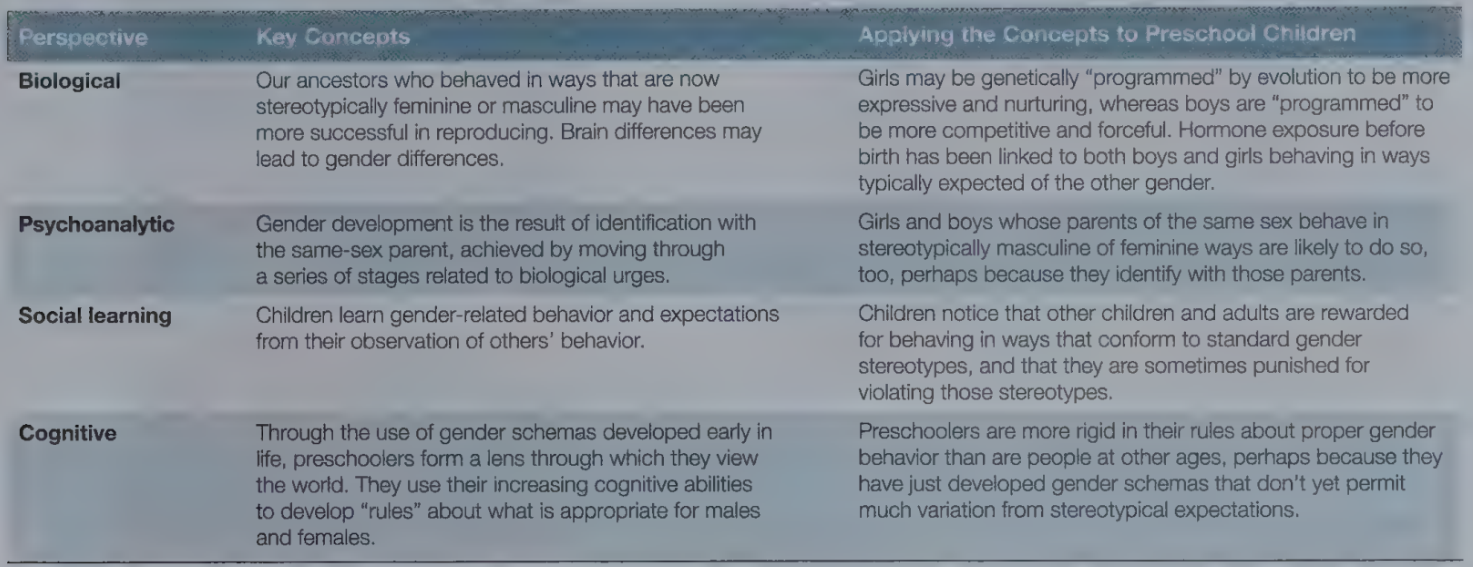
Biological approach to gender development
Our ancestors who behaved in ways now considered stereotypically feminine or masculine may have been more successful in reproducing
Hormonal differences can affect gender-based behavior (androgens, etc.)
Identification
The process in which children attempt to be similar to their same-sex parent, incorporating the parent’s attitudes and values
Associated with Freud’s psychoanalytic explanation of gender acquisition
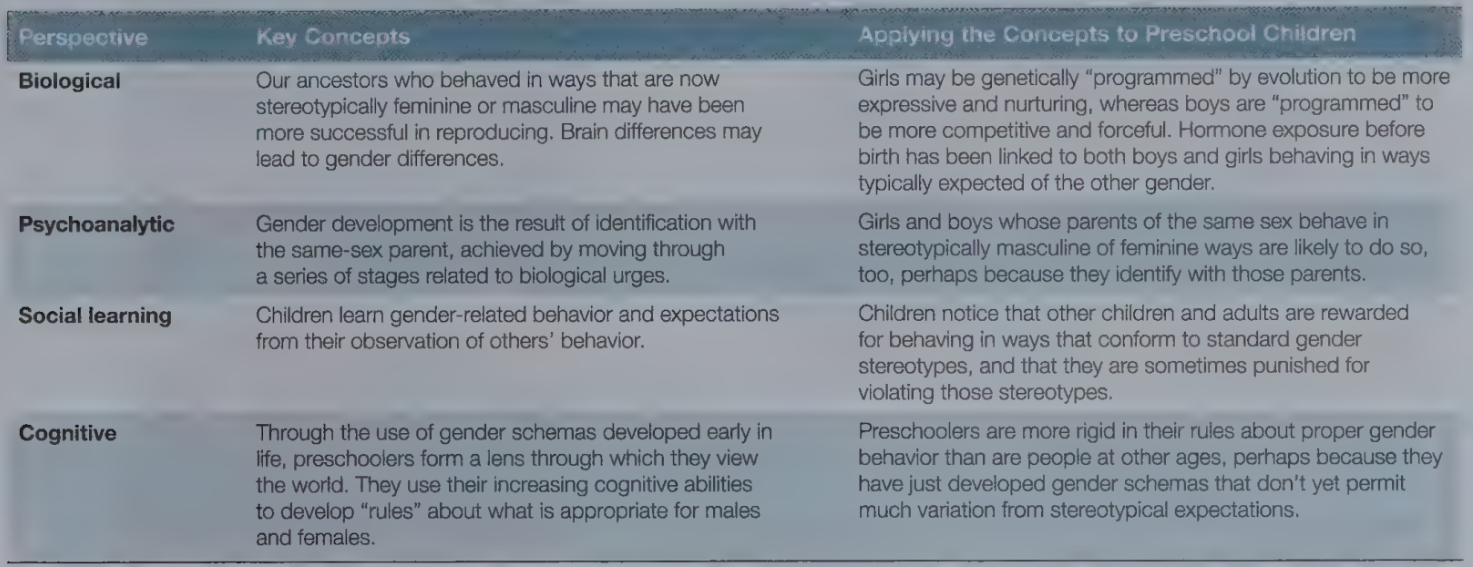
Social learning approach to gender differnences
Children observe others like themselves and attempt to mimic them, especially when the observee is rewarded for behaving in a gneder-appropriate manner
Television and media also plays a large role because of its depictions of men and women
Direct training sends a clear message on expected behavior
ex: phrases like “little lady” or being “a man'“
Gender identity
A perception of oneself as male or female
Gender schema
A cognitive framework that organizes information relevant to gender
ex: some girls decide that wearing pants is inappropriate for a female
and apply the rule so rigidly that they refuse to wear anything but dresses
Associated with the cognitive approach to gender development
Cognitive developmental theory by Lawrence Kohlberg
Gender rigidity is in part a reflection of preschoolers’ understanding of gender
Gender constancy
The fact that people are permanently males or females, depending on fixed, unchangeable biological factors
Occurs around age 4 or 5
Doesn’t affect gender-related behavior
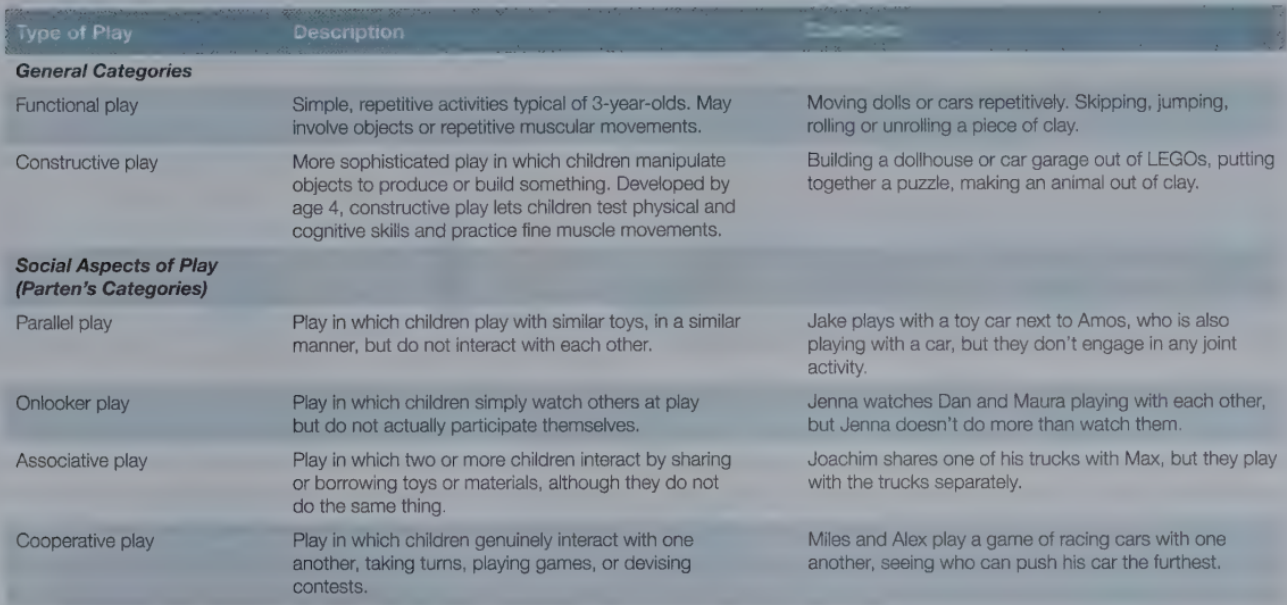
Functional play
Play that involves simple, repetitive activities typical of 3-year-olds for the sake of being active opposed to creating an end product
Ex: playing dolls or cars, skipping, jumping
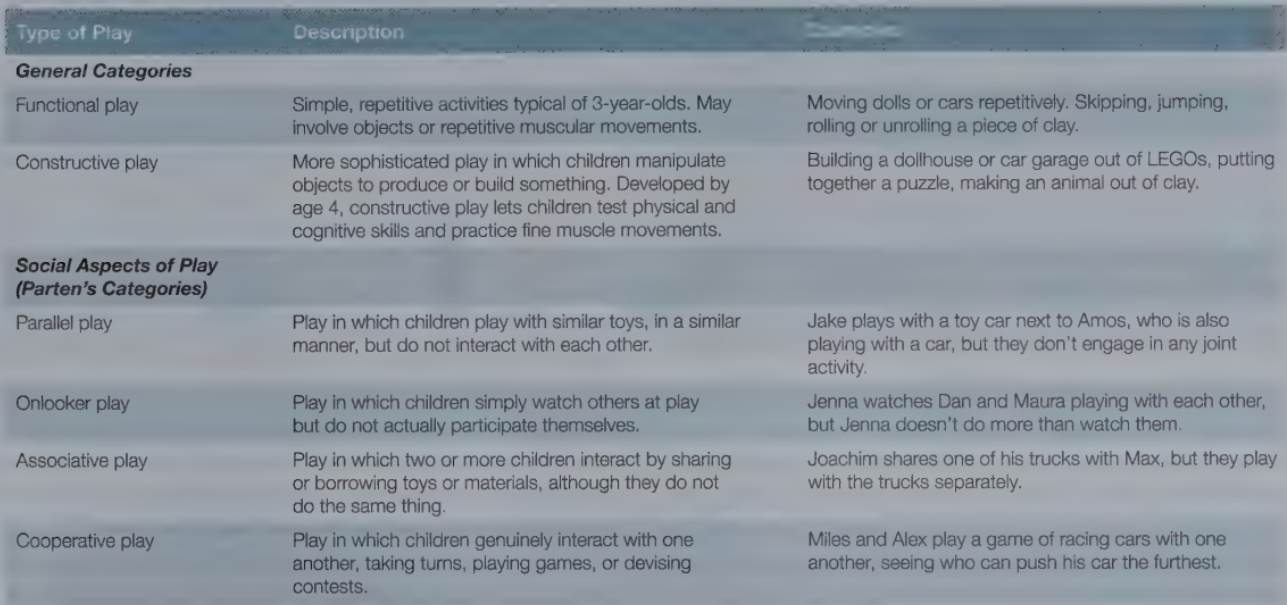
Constructive play
Play in which children manipulate objects to produce or build something that is typical of children age 4
Ex: playing legos or making a puzzle
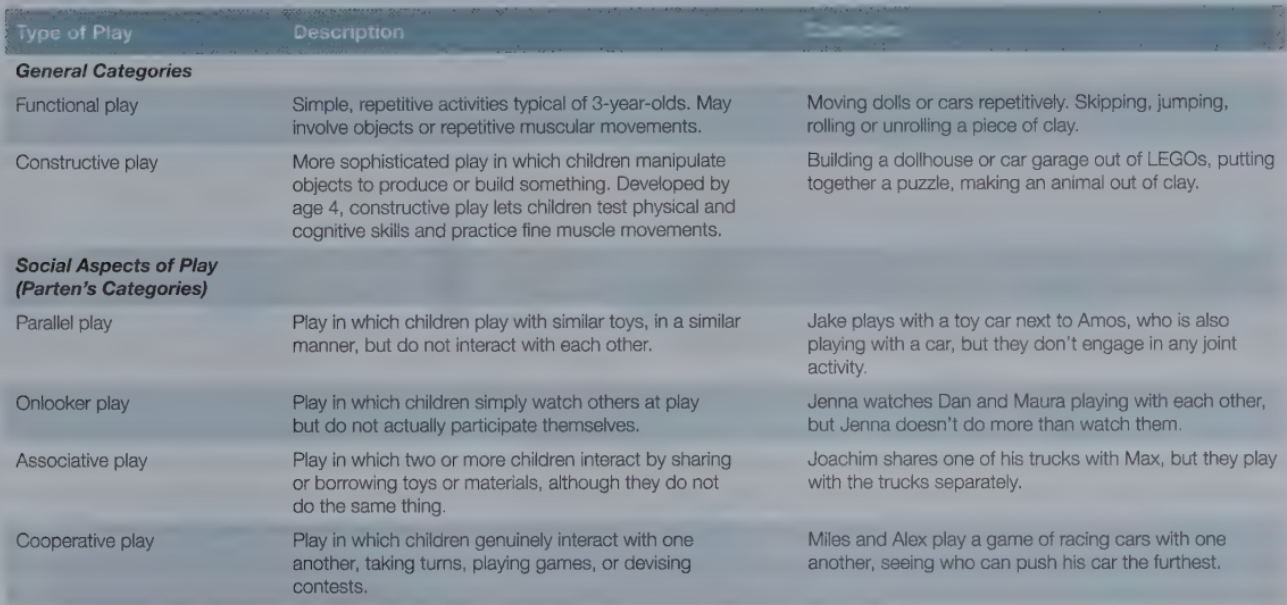
Parallel play
Play in which children play with similar toys in a similar manner, but do not interact with each other
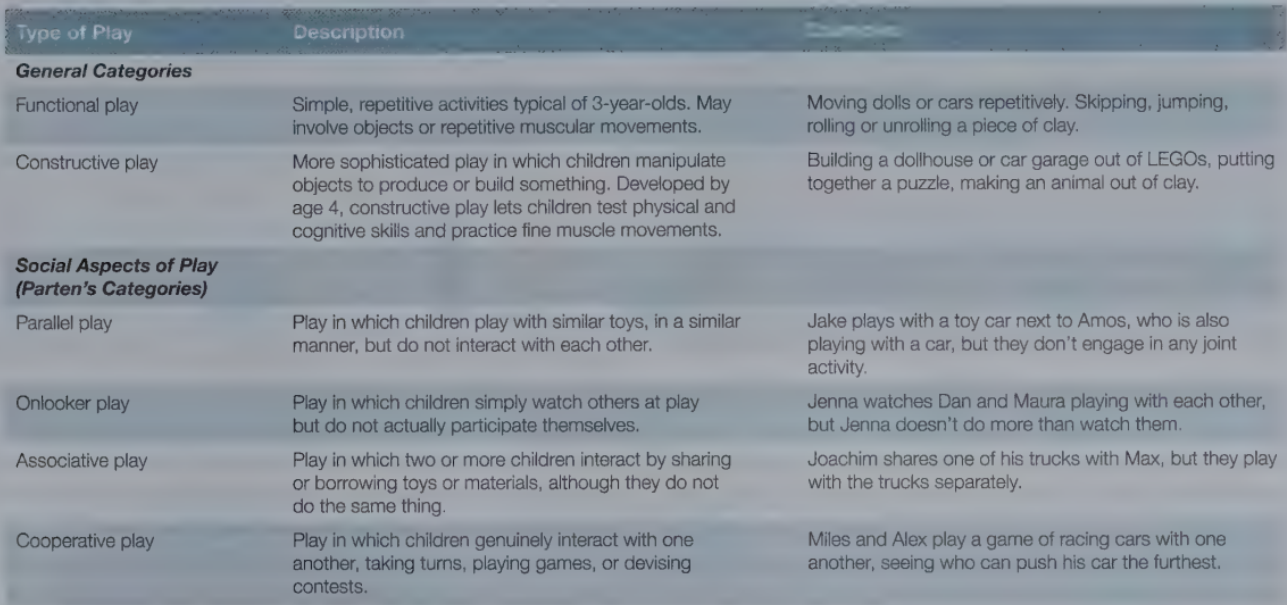
Onlooker play
Play in which children simply watch others at play but do not actually participate themselves
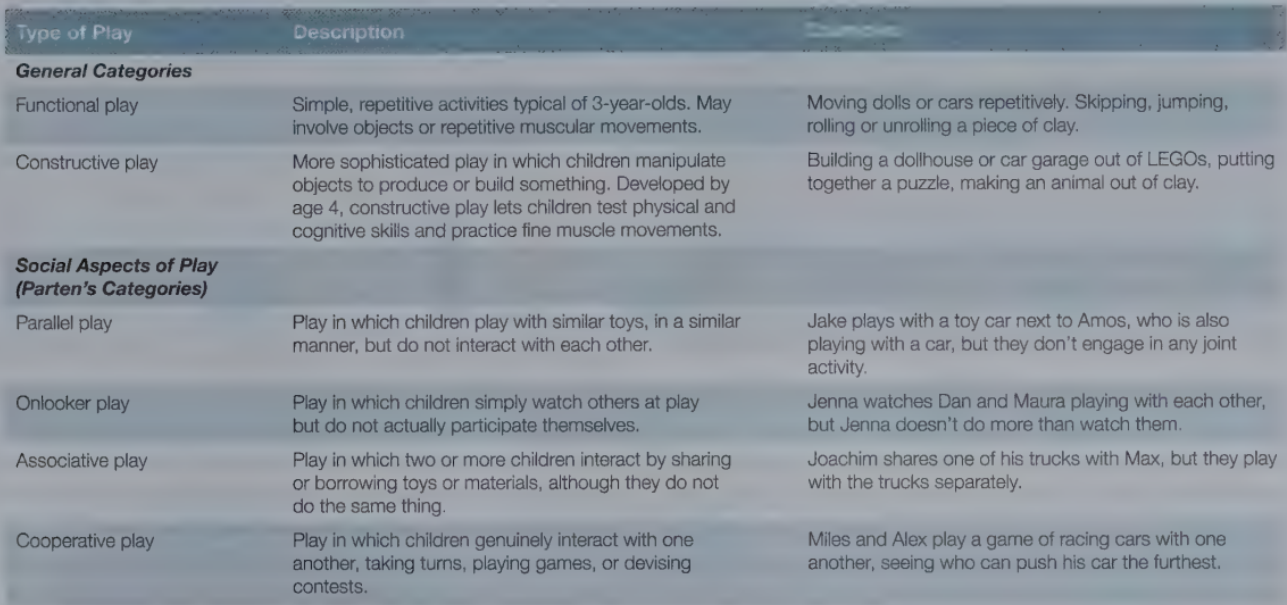
Associative play
Play in which 2+ children interact by borrowing toys or materials, although they do not do the same thing
More common towards the end of the preschool years
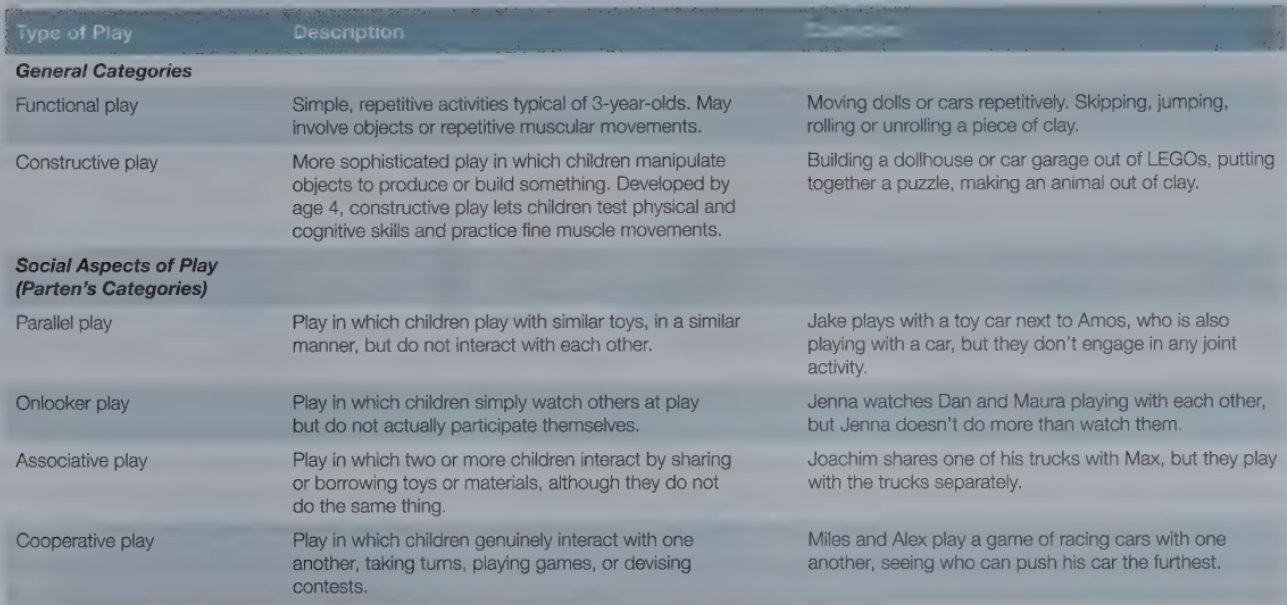
Cooperative play
Play in which children genuinely interact with one another, taking turns, playing games, or devising contests
More common toward the end of the preschool years
Preschoolers understand the concept of _____ but not _____
Pretend, belief
Beliefs are manifested in a false belief test, in which they are tested on their understanding of someone else having a belief different from theirs
A child’s developing theory of mind promotes more engaged ____ and ____ and vice versa
Social interactions, make-believe play
Authoritarian parents
Parents who are controlling, punitive, rigid, and cold and whose word is law
They value strict, unquestioning obedience from their children and do not tolerate expressions of disagreement
Demanding and low responsiveness
Their children are not social and are uneasy around their peers
Permissive parents
Parents who provide lax and inconsistent feedback and require little of their children
Undemanding and highly responsive
Their children are dependent and moody with low social skills are self-control
Authoritative parents
Parents who are firm, setting clear boundaries and consistent limits, but try to reason with their children, explaining why they should behave in a certain way
High in responsiveness and high in demand
Their children are generally the best off
Uninvolved parents
Parents who show virtually no interest in their children, displaying indifferent, rejecting behavior
Low in responsiveness and undemanding
Their children feel unloved and emotionally detached
Moral development
The maturation of people’s sense of justice, of what is right and wrong, and their behavior in connection with such issues
Heteronomous morality
The earliest stage of morality in which rules are seen as invariant and unchangeable
Belief in imminent justice
Ages 4-7
Incipient cooperation morality
The 2nd stage of morality in which games become more social and everyone plays to the same set of unchangeable rules
Ages 7-10
Autonomous cooperation stage
The 3rd stage of morality in which children recognize that formal games rules can be modified if the people who play them agree
Age 10 and onward
Imminent justice
The notion that broken rules earn immediate punishment, even if no one sees the rule break
Children have been proven to understand intentionality by about age ___
3
Prosocial behavior
Helping behavior that benefits others
Piaget emphasizes how _____ lead to _____, social learning approaches focus more on how ______ produces _______
Limitations in preschoolers’ cognitive development, particular forms of moral reasoning
The environment in which preschoolers operate, prosocial behavior
Children learn moral behavior directly through _____ and indirectly through ____
Reinforcement, observing models who receive reinforcement
Abstract modeling
The process in which modeling paves the way for the development of more general rules and principles
Empathy
An emotional response that corresponds to the feelings of another person
An increase in empathy, as well as negative emotions like shame or righteous anger, leads to an increase in moral behavior
Aggression
Intentional injury or harm to another person